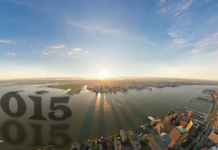Man has been able to successfully adapt to the harshest of locations on our planet. There are many inaccessible islands on Earth which inhabit a scanty population which thrives in spite of the remoteness of the island. One such place is the island of Tristan da Cunha which earns its reputation as having the most remote community on Earth. It is one of the few inaccessible islands which has about 80 families in total.
2,430 km to the closest neighbour. That’s the concept of “local” for the 263 inhabitants of the South Atlantic island of Tristan da Cunha, making their community the most remote on Earth. The nearest inhabited land, the island of Saint Helena, is located 2,430 km to the north, or the same as the distance between Moscow and Amsterdam.

The closest mainland is South Africa, 2,800 km to the east. Tristan da Cunha forms part of an archipelago under British rule including a total of six islands. The 98 km2 island mainly consists of a fertile stratovolcano rising 2,062 m above the ocean surface. The only flat area is located towards the north-west, where you will find the islanders’ homes in the village of Edinburgh. The Tristans go all the way back to 1816.
Referred to as ‘Utopia’, THIS Place Receives many applications to join the society, but no ‘outsiders’ are allowed to buy land or settle here.
Napoleon was placed under house arrest on the island of Saint Helena, and the British feared that France would use other Atlantic islands to launch an attack. So, the UK stationed a corporal and his family on Tristan da Cunha. Until 1908, the island experienced limited immigration. Today, the population lives by agriculture, fishery, and the sale of coins.

Some Facts about Tristan da Cunha:
The UK stationed Corporal William Glass and his family in 1816. Over the years, more men arrived, and so, a whaler fetched five women from Saint Helena. All islanders descend from these five women and Mrs Glass.
Seven families: All Tristans descend from six women and eight men, so there are only seven family names on the island: Glass, Green, Hagan, Lavarello, Repetto, Rogers, and Swain.
Volcanic refugees for 1.5 years: In 1961, the volcano of the island erupted, and the entire population was evacuated to England. Most chose to return 18 months later.
Successful community: There is no unemployment on Tristan da Cunha. People are busy running, for instance, a shop, a cafe, a school, and two churches. Once a year, a ship with supplies and mail arrives from Saint Helena.
Animals and plants: The Tristans breed cattle and chickens and they grow potatoes in small gardens. The island is also endemic to several wild animal species such as the Tristan albatross.
Whatever may be the reasons, the residents of this remote island should be complimented for their tenacity of going back to their home in spite of the volcanic eruption and the other challenges that living on such an isolated land pose.
-end-




































